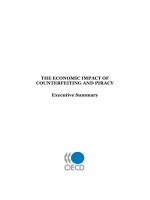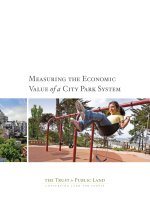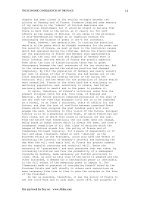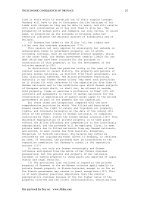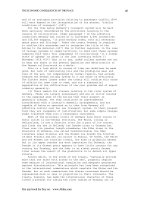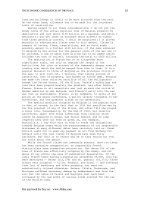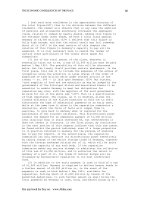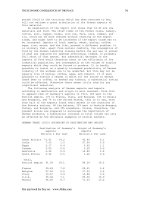The settler economies studies in the economic history of kenya and southern rhodesia 1900 1963
Bạn đang xem bản rút gọn của tài liệu. Xem và tải ngay bản đầy đủ của tài liệu tại đây (3.46 MB, 303 trang )
THE SETTLER ECONOMIES
AFRICAN STUDIES SERIES 35
Editorial Board
John Dunn, Reader in Politics and Fellow of King's College, Cambridge
J.M. Lonsdale, Lecturer in History and Fellow of Trinity College, Cambridge
David M.G. Newbery, Lecturer in Economics and Fellow of Churchill
College, Cambridge
A.F. Robertson, Assistant Director of Development Studies and Fellow of
Darwin College, Cambridge
The African Studies Series is a collection of monographs and general studies
that reflect the interdisciplinary interests of the African Studies Centre at
Cambridge. Volumes to date have combined historical, anthropological,
economic, political and other perspectives. Each contribution has assumed that
such broad approaches can contribute much to our understanding of Africa,
and that this may in turn be of advantage to specific disciplines.
OTHER BOOKS IN THE SERIES
3 Land Policy in Buganda Henry W. West
4 The Nigerian Military: A Sociological Analysis of Authority and Revolt 1960-1967
Robin Luckham
5 The Ghanaian Factory Worker: Industrial Man in Africa Margaret Peil
6 Labour in the South African Gold Mines, 1911-1969 Francis Wilson
7 The Price of Liberty: Personality and Politics in Colonial Nigeria Kenneth J. Post and
George D. Jenkins
9 Dependence and Opportunity: Political Change in Ahafo John Dunn and A.F. Robertson
10 African Railwaymen: Solidarity and Opposition in an East African Labour Force
R.D. Grillo
11 Islam and Tribal Art in West Africa Rene A. Bravmann
12 Modern and Traditional Elites in the Politics of Lagos P.D. Cole
13 Asante in the Nineteenth Century: The Structure and Evolution of a Political Order
Ivor Wilks
14 Culture, Tradition and Society in the West African Novel Emmanuel Obiechina
15 Saints and Politicians: Essays in the Organisation of a Senegalese Peasant Society
Donal B. Cruise O'Brien
16 The Lions of Dagbon: Political Change in Northern Ghana Martin Staniland
17 Politics of Decolonization: Kenya Europeans and the Land Issue 1960-1965
Gary Wasserman
18 Muslim Brotherhoods in Nineteenth-Century Africa B.G. Martin
19 Warfare in the Sokoto Caliphate: Historical and Sociological Perspectives
Joseph P. Smaldone
20 Liberia and Sierra Leone: An Essay in Comparative Politics Christopher Clapham
21 Adam Kok's Griquas: A Study in the Development of Stratification in South Africa
Robert Ross
22 Class, Power and Ideology in Ghana: The Railwaymen of Sekondi Richard Jeffries
23 West African States: Failure and Promise: A Study in Comparative Politics John Dunn
24 Afrikaners of the Kalahari: White Minority in a Black State Margo Russell and
Martin Russell
25 A Modern History of Tanganyika John Iliffe
26 A History of African Christianity 1950-1975 Adrian Hastings
27 Slaves, Peasants and Capitalists in Southern Angola 1840-1926 W.G. Clarence-Smith
28 The Hidden Hippopotamus: Reappraisal in African History: The Early Colonial Experience
in Western Zambia Gwyn Prins
29 Families Divided: The Impact of Migrant Labour in Lesotho Colin Murray
30 Slavery, Colonialism and Economic Growth in Dahomey 1640-1960 Patrick Manning
31 Kings, Commoners and Concessionaires: The Evolution and Dissolution of the
Nineteenth-Century Swazi State Philip Bonner
32 Oral Poetry and Somali Nationalism: The Case of Sayyid Mahammad 'Abdille Hasan
Said S. Samatar
33 The Political Economy of Pondoland 1860-1930: Production, Labour, Migrancy and
Chiefs in Rural South Africa William Beinart
34 Volkskapitalisme: Class, Capital and Ideology in the Development of Afrikaner
Nationalism 1934-1948 Dan O'Meara
THE SETTLER ECONOMIES
Studies in the economic history of
Kenya and Southern Rhodesia 1900-1963
PAUL MOSLEY
Lecturer in Economics, University of Bath
CAMBRIDGE UNIVERSITY PRESS
CAMBRIDGE
LONDON NEW YORK NEW ROCHELLE
MELBOURNE SYDNEY
CAMBRIDGE UNIVERSITY PRESS
Cambridge, New York, Melbourne, Madrid, Cape Town, Singapore, Sao Paulo, Delhi
Cambridge University Press
The Edinburgh Building, Cambridge CB2 8RU, UK
Published in the United States of America by Cambridge University Press, New York
www. Cambridge. org
Information on this title: www.cambridge.org/9780521102452
© Cambridge University Press 1983
This publication is in copyright. Subject to statutory exception
and to the provisions of relevant collective licensing agreements,
no reproduction of any part may take place without the written
permission of Cambridge University Press.
First published 1983
This digitally printed version 2009
A catalogue recordfor this publication is available from the British Library
Library of Congress Catalogue Card Number: 82-12896
ISBN 978-0-521-24339-1 hardback
ISBN 978-0-521-10245-2 paperback
Contents
List of maps
List of tables
List of
Preface
A note on currency
Abbreviations
figures
page vii
vii
x
xi
xii
xiii
1 Introduction
1 Scope and methods
2 Background data
2 The political constraints on economic behaviour
1 Introduction: the concept of 'extra-market operations'
2 The evolution of government policy in input markets: three
case studies
3 Conclusion: scope and determinants of extra-market operations
Appendix 1: A 'stimulus-response' model of government economic
policy response in settler economies
3
4
1
1
4
10
10
13
64
68
African agricultural development
1 Introduction: a theoretical perspective
2 Long-period change among crop producers
3 Short-period response 1: the supply responses of maize
producers
4 Short-period response 2: the case of African beef cattle
Appendix 2: A note on the data for Chapter 3
71
71
76
90
101
109
The labour market
1 Introduction and background data
2 The market for unskilled labour in mines and plantations
114
114
119
Contents
Appendix
Appendix
Kenya
Appendix
3: A note on the data for Chapter 4
4'- Detailed time series on wages and employment:
and Southern Rhodesia 1905-63
5 : The African informal sector
143
148
166
5
European agriculture
1 Introduction
2 Economic performance
3 Factor proportions and their relationship to policy
Appendix 6 : A note on the data for Chapter 5
170
170
172
183
193
6
Secondary industry
1 Introduction: the problem to be resolved
2 Industries producing for final demand: income inequality and
industrial development
3 Industrial development and the market of neighbouring
countries
Appendix 7: A comparison of earnings and industrial structure in
the settler economies and three non-settler economies in the
early 1960s
Appendix 8: Income inequality and the demand for manufactures
(after Pearson and others)
195
195
232
Conclusions
234
Notes
Bibliography
Index
237
271
286
7
VI
197
208
216
Maps
Kenya and Southern Rhodesia: principal place names
1.1 Africa: 'settler economies', rain-sufficient regions, and land over 3000 feet
above sea level
2.1 Kenya and Southern Rhodesia: disposition of African reserves, by
Kenyan District Commissioners to 1915 and by Southern Rhodesian
Native Commissioners to 1910
2.2 Kenya and Southern Rhodesia: boundaries of African and European area,
as established by (Kenya) Highlands Order in Council 1939 and (Southern
Rhodesia) Land Apportionment Act 1930
2.3a Conflict over branch railway lines, Southern Rhodesia, 1920s
2.3b Alternative routes for Uasin Gishu Railway, Kenya, 1914-24
xiv
6
22
23
35
35
Tables
1.1
2.1
2.2
2.3
2.4
2.5
2.6
2.7
'Settler economies' 1960: population, land and European representation on
legislative body
'Extra-market operations': objectives, strategies and resulting policies
Kenya and Southern Rhodesia: some important land concessions before
1914
Kenya and Southern Rhodesia: prices of land in European areas, 1906-55
Kenya and Southern Rhodesia: distribution of African population by type
of land tenure, 1922-51
Rail rates for carriage of freight
a Kenya and Uganda Railway, 1914-59
b Rhodesia Railways, 1905-58
Kenya, Southern Rhodesia and Nigeria: railway rates, 1920
Kenya and Southern Rhodesia: ratios of average rail rates on 'representative baskets' of goods consumed by Africans and Europeans, 1914-59
vii
7
12
15
17
26
31
32
33
39
Tables
2.8
2.9
2.10
2.11
2.12
2.13
2.14
3.1
3.2
3.3
3.4
3.5
3.6
3.7
3.8
3.9
3.10
3.11
4.1
4.2
4.3
4.4
4.5
Southern Rhodesia: operation of maize market under Maize Control
Amendment Act 1934
Kenya 1942: price structure for maize
Prices paid for African cattle, 1938
a Southern Rhodesia
b Kenya
Southern Rhodesia and Kenya: guaranteed prices for cattle per 100 lb
liveweight, 1948
Kenya and Southern Rhodesia: price structures for maize, evolution early
1940s to late 1950s
Hypothetical profits on local sales of beef by Southern Rhodesia Cold
Storage Commission, 1961/2 buying season
Kenya and Southern Rhodesia: economic stimuli and political responses,
1903-60
Kenya and Southern Rhodesia: African agricultural development, a
general overview
Kenya and Southern Rhodesia: African marketed crop production, shares
of grain and 'pure cash-crops'
Kenya and Southern Rhodesia: African population densities
Kenya, principal African districts: sales of agricultural produce outside the
district
Kenya, principal African districts: population density, absenteeism and
cash-crop sales, 1929, 1945 and 1961
Maize exports, sales and price
a Southern Rhodesia, 1930-61
b Kenya, 1929-63
Results of regression analysis relating maize deliveries to price offered and
other variables
a Southern Rhodesia
b Kenya
Sales of cattle and certain possible explanatory variables
a Kenya, Masai districts, 1924-52
b Southern Rhodesia, 1918-40
Kenya and Southern Rhodesia: deliveries of African-owned cattle to
statutory board, 1941-63
Southern Rhodesia: frequency distribution of population/taxpayer ratios
Kenya and Southern Rhodesia: estimates of population by various
methods
Kenya and Southern Rhodesia: sectoral distribution of African employment, summary
Kenya and Southern Rhodesia: indices of African wage levels, summary
Kenya and Southern Rhodesia: rural population and agricultural production, 1914-60
Kenya and Southern Rhodesia: supply and 'demand' for African labour,
1909-60
Kenya and Southern Rhodesia: real wages in relation to the state of the
labour market, 1909-58
viii
48
51
55
56
58
60
63
65
72
74
78
86
88
92
94
98
99
102
104
108
111
112
115
116
120
126
129
Tables
4.6
4.7
4.8
4.9
5.1
5.2
5.3
5.4
5.5
5.6
5.7
6.1
6.2
6.3
6.4
6.5
Southern Rhodesia, Native Affairs Commission 1910 and Kenya, Native
Labour Commission 1912: summary of opinions expressed by witnesses on
labour supply
Kenya and Southern Rhodesia: labour surplus and shortage in primary
industries in relation to various non-wage methods of market adjustment,
1900-63
Recorded African employment and industrial distribution
a Southern Rhodesia, 1906-63
b Kenya, 1919-63
a Kenya and Southern Rhodesia: African agricultural wages, 1898-1946
b Southern Rhodesia: recorded monthly wage rates for different categories
of African unskilled labour
c Kenya: recorded monthly wage rates for different categories of African
unskilled labour
Southern Rhodesia and Kenya: share of particular farming activities in
European agriculture
a by value of output
b crop husbandry only
Yields per acre: Southern Rhodesia and Kenya in relation to other producing countries, 1920-60
a Maize
b Plantation crops
Southern Rhodesia, European maize and tobacco growers: distribution by
yield, average of crop years 1949/50 to 1954/5
European agriculture in Southern Rhodesia and Kenya, with international
comparisons: factor proportions
Southern Rhodesia, Kenya and USA: relative cost of agricultural
machinery and labour, 1923
Southern Rhodesia and Kenya: factor proportions and factor prices in
European agriculture, 1925-63
Determinants of capital intensity in white agriculture: results of regression
analysis
Kenya and Southern Rhodesia: share of secondary industry in national
income, 1924-64
a Southern Rhodesia 1957/8: average monthly income and expenditure of
unrationed African families in rent-free accommodation in Salisbury
b Kenya 1957/8: average monthly income and expenditure of Africans in
Nairobi
c Southern Rhodesia 1950/1: distribution of European families by income
and expenditure groups
Kenya 1926-52: results of regression analysis linking imports of cotton
piece goods and bicycles to African cash income
Kenya, Southern Rhodesia and three 'non-settler economies': size of
market for manufactures in relation to national income, early 1960s
Kenya and Southern Rhodesia: exports of manufactures
a 1930
b 1951
ix
132
136
149
152
155
158
162
171
171
173
174
177
184
185
190
192
196
199
200
201
204
205
209
210
Tables
6.6
6.7
6.8
6.9
6.10
6.11
Kenya and Southern Rhodesia: sales of manufactures to neighbouring
countries as a percentage of total industrial production, 1930-64
'Settler' and 'non-settler' economies: manufactured exports in relation to
gross output in manufacturing, early 1960s
Kenya and Southern Rhodesia: direction of export trade, 1914-64
Kenya and Southern Rhodesia: balance of trade, 1914-64
Secondary industry: imports, exports, and domestic production
a Southern Rhodesia, 1964
b Kenya, 1961
c Uganda, 1963
d Jamaica, 1960
e Ghana, 1959
'Settler economies' and peasant export economies: racial distribution of
incomes from employment, 1960
211
213
214
215
218
221
224
226
228
230
Figures
3.1 Southern Rhodesia, African reserve areas: arable acreage per capita and
grain productivity, 1913 and 1938.
3.2 Western Province of Kenya: deliveries of maize to West Kenya Marketing
Board, Marketing Board buying price, and price across the border in
Uganda, 1947-65.
3.3 Masai districts of Kenya: sales of cattle, government policy measures and
price of bullocks at Narok, 1924-51.
4.1 Kenya and Southern Rhodesia 1914-60: estimate of African per capita
income from wage employment and peasant agriculture.
4.2 Kenya and Southern Rhodesia 1905-60: periods of excess demand for
African unskilled labour, with wage and non-wage responses.
5.1 Southern Rhodesia 1923-36: yield per acre by size of maize lands.
5.2 Southern Rhodesia: European maize growers, six-year average 1949/501954/5, distribution by yield group and percentage of crop reaped.
5.3 Kenya and USA 1923: factor prices and technical options in European
agriculture.
6.1 Southern Rhodesia: urban Africans 1957/8 and Europeans 1950/1, patterns
of expenditure in relation to income.
6.2 Kenya, Southern Rhodesia and two 'peasant export economies': Lorenz
curve estimate of distribution of incomes from employment, 1960.
81
97
106
122
140
175
176
188
202
231
Preface
This book is a revised version of my PhD thesis, which was researched
between 1976 and 1980 and finally submitted to Cambridge University in
1980. During those four years the focus of the research project broadened
from the mere assembly of a data base for parts of the economic history of
Kenya and Southern Rhodesia in the colonial period into a critique of
certain versions of 'underdevelopment theory' which have now become a
conventional wisdom for the interpretation of that history. The concepts
and empirical validity of 'underdevelopment theory', of course, have
recently been under scrutiny all over the underdeveloped world, not just in
the countries examined here; I therefore hope that the book may have some
interest for students of areas other than Eastern and Southern Africa.
Quite the pleasantest part of the job of writing the book is to thank those
who helped me do so. I should have been lost without the patient and
understanding help of Charles Feinstein in the painful early years of research. My present employer, the University of Bath, financed my visit to
the National Archives of Rhodesia in 1978. John Lonsdale, Michael Redley
and Carl Keyter helped enormously with encouragement, introductions to
unfamiliar material and criticisms of half-baked ideas. The interviewees
listed in Section E of the bibliography endured my questions with great
courtesy, and filled some vital gaps in the documentary sources. Walter
Elkan, the external examiner of the thesis, did his best to encourage me to get
rid of some of the more tangled bits of exposition in the original version,
and if the result does not have the Orwellian simplicity of his own prose,
that is very much on my head. Lynette Latchem, as I have come to expect,
did a lovely job of typing the final manuscript. Finally, Helen WeinreichHaste lived with this piece of work from start tofinish;she showed exemplary
tolerance, in particular at those times when the raw materials for it spilled
off my writing desk and threatened to invade the entire house, and I owe
everything to her love and moral support.
May 1981
PAUL MOSLEY
XI
A note on currency
The currency of both Kenya and Southern Rhodesia during the period
of this study was the pound, which was kept at par with the pound sterling.
The pound was divided into twenty shillings (except in Kenya between
1895 and 1921 when it was divided into fifteen rupees; but in this text all
rupee values are converted into pounds and shillings). The shilling was
divided, in Kenya, into one hundred cents, and in Southern Rhodesia into
twelve pence. Money values in this book are thus given in one of three
alternative forms:
£13
)
~ ,. n .
f Kenya
and Southern Rhodesia
J
2 shilhngsj
Sh. 2.75 or 2.75 (Kenya)
two shillings and seventy-five cents
8s. 4d. or 8/4 (Southern Rhodesia)
eight shillings and four pence
xn
Abbreviations
For abbreviations used in references, see the bibliography. Briefly, the
following system is used:
Archival sources and debates are referred to by means of the individual
letters of the archive (or series) in question, as shown at the beginning of the
bibliography. Non-serial government publications and all secondary materials,
published and unpublished, are referred to by author's name, year and
numbered section of the bibliography (e.g. B3, Dl, as shown at beginning
of the bibliography). Serial reports from statutory bodies are given the full
reference in the notes.
The following abbreviations are used in the text:
BSAC
CNC
DC
KFA
MLA
NC
PC
British South Africa Company
Chief Native Commissioner
District Commissioner
Kenya Farmers' Association
Member of Legislative Assembly
Native Commissioner
Provincial Commissioner
xni
Naivasha\
.S.NYANZA
VortHall
\KI^MBU
200 miles
•M-»-Railways built by 1930
|
Southern Rhodesia
Kenya and Southern Rhodesia: principal place names.
XIV
1
Introduction
1.1 SCOPE AND METHODS
'Settler colonialism',1 as practised in this century in countries such as
Kenya, Southern Rhodesia, Algeria and South Africa, is a rather odd
phenomenon: it throws out a challenge, by its very existence, to both the
apologist for colonialism and to the 'underdevelopment theorist'. The
former must come to terms with the restrictions placed on many parts of the
indigenous economy in spite of the presence of a colonial administration
nominally exercising 'trusteeship'; the latter must face the fact that settler
economies quickly develop an economic nationalism of their own and to
that extent fail to fit the classical-imperialist model of underdeveloped
countries whose economic policy and development are dictated by the
needs of the European metropolis.2 In the last ten years, a large quantity
of archive-based work has vastly increased our knowledge of such 'settler
economies', in particular the two studied here.3 But in fact most of this
work consists of studies by historians of policy-making, since this is what
the archives give most information about. By their very nature, such studies
cannot shed any light on the development of the economy; this is often
left to be inferred from a description of policy measures, rather than explicitly examined. Only the labour market has been at all intensively studied
by economists on a time-series basis, and even there, the data base before
1945 is alarmingly weak.4 As a result, our knowledge of the actual operation
of the economy in settler states is at best based on questionable data and at
worst on stereotypes, most of them falling within the general ambit of
'underdevelopment theory': the regression of the peasant economy, the
stagnant real wage, the inefficient white farmer, the constraint imposed
on industrial expansion by the peasant economy's decline. The research
which produced these stereotypes has, at least, performed the service of
driving out the more ancient colonial myth that underdevelopment in
Africa was due to the absence of an economic spirit among Africans.5
But it has not, as yet, provided a strong body of data concerning the operation
of settler economies against which the stereotypes can be tested. The first
1
The settler economies
task of this study, therefore, is to build up the existing data base. We can
then proceed to trace certain elements in the economic history of a couple
of 'settler economies', Kenya and Southern Rhodesia. We do this over the
entire colonial period from 1900 on, for reasons stated below: it follows
that the number of elements we can choose is severely limited. We consider
four here (African agriculture, European agriculture, the labour market,
and secondary industry), but even within these headings specialisation has
to be practised, so that the agricultural chapters are heavily biased towards
cattle and maize. In addition, both the historical approach adopted and
the character of the data available constrain the type of model that can be
tested. For example, micro-economic models of motivation and factor
allocation in African agriculture, such as those on which much of the literature on agricultural underdevelopment has focused,6 cannot be tested against
the time-series data on which we rely here, and models of labour stabilisation
cannot be tested without information on the breakdown of the labour force
by earnings groups, which we lack. In both cases we have to fall back on
cruder models and very limited methods of evaluating them, especially since
the data are often so bad. However, even the limited evidence we are able to
assemble is of such a type as to cast doubt on the four neo-orthodox stereotypes listed above. An important factor in the argument is that whereas the
sources discussed above rely largely, in order to make such inferences as
they do about the behaviour of the economy, on verbal evidence, e.g. the
testimony of District or Native Commissioners, our own inferences are made
largely from statistical evidence, much of it from archival material not
previously explored for this purpose.
This study, therefore, is weighted towards the analysis of economic
behaviour rather than policy-making, but the four chapters on economic
behaviour are prefaced with a long chapter on the evolution of three facets
of economic policy: land, railways and agricultural marketing. The purpose
of this is to define the constraints within which economic behaviour operated.
These constraints stemmed from past experience of policy and its influence
on expectations as well as from present restrictions on economic activity.
Much of this material must be explicitly developed within Chapter 2 from
original sources since the existing literature (for example, that cited in
note 3 above) frequently gives an inadequate picture. In particular, the
element of conflict within the settler-producer group (Arrighi's 'white rural
bourgeoisie')7 and the influence which this conflict exercised over the
eventual policy outcome have, with certain distinguished exceptions,8 been
glossed over, with the result that the making of economic policy is too often
represented as a straightforward contest between European and African
producer interests subject to intervention by the metropolitan power. This
is to understate the influence of internal constraints on the policy-making
process.
The historical development of the settler economies must, indeed, be
seen as a process of mutual interaction between the economy and the political
Introduction
9
system, with the state of the economy (or its perceived state) playing a part
in determining policy and simultaneously being so much influenced by policy
variables that a theoretical model which omits them often gives a picture
which is the reverse of the truth.10 For simplicity we may divide up this
process of simultaneous causation into two legs':
1
political
system
«
economy
>
Relationships of type 1 - in which the state of the economy and other
variables determine the evolution of policy variables - are dealt with mainly
in Chapter 2 below, and relationships of type 2 - in which policy variables
inter alia determine the evolution of the economy - are dealt with mainly
in Chapters 3 to 6 below. The order of the chapters is designed, so far as is
possible, to present a sequential argument: thus variables which are endogenous in Chapter 2 (land prices, railway rates, and marketing policies) are
exogenous to Chapters 3 and 5, on African and European agriculture respectively; the productivity of African agriculture, which is endogenous to
Chapter 3, is exogenous to Chapter 4 on the labour market; and the distribution of personal income, which is endogenous to Chapter 4, is exogenous
to Chapter 6 on industrial development. A long period - practically the
whole colonial period, in fact11 - is examined, partly because the theories
from the 'underdevelopment' stable which are reviewed - for instance, in the
field of agricultural evolution and the development of the real wage level are themselves long-period in character, and partly also in order to illustrate
that matters which have been portrayed as static throughout the colonial
period - for example, the response of economic policy to crisis in the economy and the inefficiency of European agriculture - in fact varied considerably through time. This implies, sadly, a large sacrifice of descriptive detail.
The function of this study is largely to analyse certain economic and political relationships for themselves rather than to serve as an essay in comparative economic systems. However, the analysis of Chapters 2 to 6 inevitably
throws up the question of whether 'the settler economy' is sufficiently
distinctive, either in terms of institutions or in terms of behaviour, to deserve
classification as a species on its own. We consider this question in the concluding Chapter 7, largely on the basis of comparisons in the body of the
text between the two 'settler economies' discussed here and other less developed economies of the kind most often presented as a contrasting ideal
type, namely 'peasant export economies'.12 Our conclusions are tentative;
this study makes no pretence at a comprehensive coverage of the economy,
and the data it uses are frequently not good enough for firm conclusions to
be drawn from them. The validity of the data series presented is discussed
in Appendices 2, 3 and 6, which consider the sources for the chapters which
The settler economies
use archival material to supplement existing published series. On some
occasions regression analysis is conducted between variables whose basis
of measurement is far from ideal, on the grounds that the relationship
in question is sufficiently interesting to warrant our saying whatever can
validly be said on the strength of the available information. Where this is
done, the fact is advertised and analysis is confined to an inspection of the
size and significance of the regression coefficient, plus in some cases a search
for factors systematically associated with the residuals from the regression.
But it is possible that in some cases the errors in the data may be such as to
invalidate the standard significance tests.
The orientation of the study is positivistic, in the sense that it searches for
conclusions about the economies under discussion which hold good regardless of the investigator's value position, and also in the sense that it generally
attempts to proceed by testing specified hypotheses. The conclusions it
arrives at by this method frequently, as we have already indicated, challenge
the conclusions reached on certain aspects of Kenyan and Southern Rhodesian economic history by members of the 'underdevelopment' school of
historical and social science writing. It is therefore particularly important
to acknowledge the influence of that school on the present work: most of the
research reported on in this study owes its original stimulus to ideas formulated by its members, and in particular the practice of treating government
policy as an endogenous variable, adopted in Chapter 2, owes much of its
inspiration to the methodological introduction to Arrighi's The political
economy of Rhodesia (1967 (D2)). More generally, in an essay originally
published three years after The political economy of Rhodesia, Arrighi wrote
the following words, in criticism of the earlier study of Barber (1961 (D2))
which had used a modified Lewis model to analyse the Central African labour
market:
Causal relations . . . are not derived from historical analysis, but are imposed
from within, that is, through a priori analysis; and a set of assumptions which
yields the 'stylised facts' is held to have explanatory value, irrespective of its
historical relevance. But since there will normally be many such sets, this methodology leaves room for considerable arbitrariness of choice and therefore for
mystifications of all kinds. In view of this, the low scientific standards attained by
modern 'development economics' and, for that matter, by economics in general
should surprise nobody. 13
It was a desire to respond to this challenge, more than anything, which
prompted the present study.
1.2 BACKGROUND DATA
This section provides the bare minimum of background information as the
main function of the study is analytical rather than descriptive and many
good descriptive summaries of colonial Kenya and Southern Rhodesia
Introduction
already exist. But it will be useful to provide some brief comparative material
here under the three headings: distribution of land and people; agro-climatic;
and constitutional. It will be useful to read the first two subsections in conjunction with Map 1.1.
Distribution of land and people
We have taken as our working definition of a settler society a country partly
settled by European landowner-producers, who have a share in government,
but who nonetheless remain a minority of the population and who in particular remain dependent, at least for labour, on the indigenous population
(see note 1). This definition produces the following representative short-list
of 'settler' societies in Africa and Asia. The current designation for the country, if different from its colonial name, follows in parentheses.
South Africa
Kenya
Southern Rhodesia (Zimbabwe)
Angola
Belgian Congo (Zaire)
Ceylon (Sri Lanka)
Swaziland
Bechuanaland (Botswana)
Northern Rhodesia (Zambia)
Mozambique
Algeria
Malaya (Malaysia)14
This short-list forms the basis for Table 1.1, which compares these twelve
countries by ethnic breakdown and share of whites in landownership and
legislation. It is at once apparent that a feature of all settler societies was
the ability of the immigrant group to obtain for themselves a disproportionate share in landownership. Kenya is near the bottom end of the list in
terms of proportion of white population to the total; Southern Rhodesia
is near the middle on this criterion, but exceeded only by South Africa
in acreage of European-reserved land per head of white population.15
Agro-climatic data
As will be seen from Map 1.1, all the African 'settler economies' listed in
the table satisfy the following conditions: a large part of the country is more
than 3000 feet above sea level, and enjoys annual rainfall of more than twenty
inches. These indices are highly correlated with one another and with a
third precondition for large-scale European settlement, namely freedom
from tsetse fly.16 These were considered to be minimum conditions for successful agricultural settlement by white farmers. But at this point it is worth
making a distinction between those colonies in Table 1.1 which enjoyed for
the most part an average annual rainfall of more than forty inches, i.e. the
Belgian Congo, Ceylon, and Malaya, and the others. For the first group was
suitable essentially for plantation agriculture of crops such as tea, rubber
and palm oil, and not for the pursuit of 'temperate farming' activities cereal growing and cattle raising by Europeans. The second group, which
The settler economies
UNION OF
SOUTH < O
AffOCA
Land more than 1OOOm (3280 ft) above sea level
' ' Inner boundary of 'rain-sufficient'zone (area with more
than 75per cent probability of 20ins (508mm) annual rainfall)
(j)
1000 miles
1
6
2000km
Map 1.1 Africa: 'settler economies', rain-sufficient regions, and land over 3000 feet
above sea level. Source: Bennett 1962 (D3).
was not suitable for plantation agriculture, exhibits a distinctive pattern
of economic policy; for whereas in plantation economies the production
of food was an activity entrusted purely to indigenous producers, 17 in the
others it was an activity in which competition between indigenous and white
Table 1.1. 'Settler economies' 1960: population, land and European representation on legislative body
Country
Landownership
Population
Representation on legislative body
Percentages of total
Total
(thousands
of square
Indigenous Other miles)
Alienated or Other
reserved for
Europeans
Percentages of total
Total
(thousands) European
Kenya
S. Rhodesia
Republic of
South Africa
Swaziland
Bechuanaland
N. Rhodesia
Angola
Mozambique
Algeria
(excluding
Saharan
territories)
Belgian Congo
(1958)
Ceylon
Malaya
Percentages of total
Total
membership
6 587
3 070
1.0
7.1
95.6
92.2
3.3
0.5
225
150
7
49
93
51
15 841
252
298
2 420
4 550
6 300
19.4
2.8
1.0
3.0
3.5
1.3
68.2
96.4
99.0
96.7
12.4
0.8
0
0.4,
96T 5
98.7
472
7
220
290
481
297
87
51
6
3
-
13
49
94
97
-
8 500
11.8
88.2
128
14
86
_
13 000
9 000
6 909
0.8
0.9
0.5
902
25
51
9
14"
lb
91
86
93
41
95
52
32
30
164
no legislature
no legislature
26
26
31
European European
unofficial officials
NonEuropeans
34
100
38
0
28
0
96
0
0
50
69
52
4°
0
0
42"
31°
48
0
0
0
8
0
0
_
_
_
53
3
0
27
0
0
20
97
100
v
99.2
86.0
50.1
13.1
49.4
- not available
Notes:
"In Northern Rhodesia and Angola two of the European officials in the legislature were nominated to represent African interests. In South Africa
three European officials were nominated to represent African and four to represent Coloured interests.
*The entire area under plantation crops in Malaya and Ceylon, i.e. rubber, oil-palm, coconut, pineapple and tea, is taken to be under the ownership
of European individuals or companies in 1960: this is a slight but not a gross over-estimate.
Sources: Population and landownership, African territories: Yudelman 1964 (D3), Tables 1 (p. 5) and 2 (p. 19); Gann and Duignan 1962 (D3),
Appendix.
Representation on legislative body, African territories: Hailey 1957 (D3), Chapter 6.
Ceylon, all data: Oliver 1957 (D3); World Bank 1961 (D3).
Algeria, all data: Andrews, 1962 (D3); Saint-Germes 1950 (D3).
Malaya, all data: Silcock and Fisk 1963 (D3).
The settler economies
settler-producers was always present to some degree. Since indigenous
producers could nearly always produce at lower cost, and immigrant producers were subject to diseases and climatic uncertainties not known in Europe,
the immigrants' competitive position was weak; pressure for discriminatory
action in restraint of such competition, at any rate in times of depression,
was therefore also always present to some degree. To be sure, temperate
farming activities never monopolised economic activity in the settler economies ; parts of Kenya and Southern Rhodesia, to say nothing of the rest
of the 'settler economy' group, were perfectly suitable for the growing of
'plantation crops' which were generally export-oriented and too capitalintensive for indigenous Africans to be able to get much of a competitive
foothold.18 Southern Rhodesia additionally supported mining activity
which shared the same characteristics. But it is the existence of an economically insecure temperate foodstuff-growing white agricultural producer
group, and of state action to protect it, rather than the much more frequently
publicised intervention in the labour market19 which marks off the true
settler economy, as we shall henceforth call the first nine countries in Table
1.1, from the plantation economy.
Systems of government
All of the territories listed in Table 1.1 were, for the larger part of our period,
parts of the empire of a European country. But this general statement masks
enormous differences in the degree of self-determination which they possessed. The whole of South Africa from 1910 on, Ceylon from 1947 on, and
Malaya from 1957 on enjoyed Dominion status within the British empire,
i.e. effective internal self-government. At the opposite pole, the 'High
Commission territories', Bechuanaland and Swaziland, had no internal
legislative body at all for the whole country; rather, tax collection, public
works and law and order were administered by a colonial bureaucracy
under a Resident Commissioner subject to the direction of the High Commissioner for the United Kingdom in South Africa; this, incidentally,
excludes them from that definition of 'settler societies' which is based on the
representation of European producers in the legislative system.
All the other territories occupy an intermediate position, i.e. throughout
the period 1900-60 they were governed by a legislative council with some
non-official representation on it, but its legislation was subject to some sort
of metropolitan veto. The composition of these bodies changed frequently
during the colonial period;20 the position in 1960 is given in the right-hand
column of Table 1.1. But within this intermediate group Southern Rhodesia
stands on its own, since although nominally a colony it enjoyed after 1923,
as Lord Hailey's survey puts it, 'so much the aspect of a Dominion that it
is treated as lying within the sphere of interests dealt with by the Commonwealth Relations Office (the old Dominions Office) in the United Kingdom'.21 Specifically, after that date it was governed by a thirty-member
Introduction
Legislative Council elected by a franchise, the income and property qualifications for which excluded almost all Africans throughout our period.22
Any legislation passed by this Council which had the effect of discriminating
between the races was by an Order in Council of 1898, which remained in
force in the 1923 constitution, subject to the approval of the Secretary of
State for the Colonies. But this veto was never meaningfully invoked.
In all the other colonies in the 'intermediate' group, unlike Southern
Rhodesia, there was additional metropolitan restraint on the actions of the
legislature mediated through official representation on that body. But the
influence on economic policy, at any rate, of this restraint can be exaggerated.
The differences in policy, for example, between Southern Rhodesia with a
white unofficial monopoly on the legislature after 1923, and Kenya with no
white unofficial majority, were much watered down by white unofficial
majorities in Kenya on critical executive bodies such as the Board of Agriculture and Land Settlement Board, and white unofficial parity on the InterColonial Railway Advisory Committee.23 In Chapter 2 these specific
differences in policy will be explored in detail, although the emphasis will
be on the policy out-turn rather than on the political and administrative
machinery by which it came into being. It will be noted from Table 1.1 that,
in general, the white unofficial element in the legislature was less in the
'plantation economies' than in the 'true settler economies'.24
To summarise, it is possible to whittle down our original short-list of
'settler economies', set up on the intuitive definition of territories where
European producers owned land and were dependent on the labour of
indigenous people, in either of two ways to make the definition of the species
more precise. The requirement that the white producers in question should
have representation on a legislative body excludes Bechuanaland and Swaziland. The more contentious, but more meaningful, requirement that they
should to some extent be in economic competition with indigenous food
producers excludes also Ceylon and Malaya, and arguably the Belgian
Congo. This second definition leaves Bechuanaland, Swaziland, South
Africa, Algeria, Angola, Mozambique, and Northern Rhodesia, in addition
to Southern Rhodesia and Kenya, as examples of 'settler economies'
proper. The expression 'settler economies' is intended, where used later
in this book, to refer to this group. The expression 'the settler economies'
will in future be applied to statements intended to be true specifically for the
two countries, a case study of which takes up the whole of the rest of the
book: Kenya and Southern Rhodesia.
The political constraints on economic
behaviour
2.1 INTRODUCTION: THE CONCEPT OF 'EXTRA-MARKET
OPERATIONS'
In this chapter, by contrast with those that follow it, our focus is on the
influence of economic factors on political variables. The dependent variables
in question are three areas of economic policy - land policy, railway policy
and marketing policy - which had important influences on the pattern
of economic development, examined in Chapters 3 to 6 below. Each of
these 'areas of policy' consisted essentially of intervention in the market
for a critical factor of production. What kind of intervention materialises
in any given historical case is, of course, a question of which groups have
power to intervene in the market and what kind of intervention they perceive
as being in their best economic interests. On these matters, however, as
Rothschild has reminded us, conventional economic theory is silent:
If we look at the main run of economic theory over the past hundred years we
find that it is characterised by a strange lack of power considerations. More or
less homogeneous units-firms and households - move in more or less given
technological and market conditions and try to improve their economic lot
within the constraints of these conditions. But that people will use power to alter
the mechanism itself; that uneven power may greatly influence the outcome of
market operations; that people may strive for economic power as much as for
economic wealth: these facts have been largely neglected.1
This theoretical gap is particularly unfortunate in the context of societies
in which, as Murray has noted in the Southern Rhodesian case, 'the administrative system favoured political agitation rather than more efficient production as the means for earning a bigger income'.2 In what follows, no attempt
is made to fill the hole in a formal sense. What is offered in this chapter,
rather, is first, an elementary typology of 'extra-market operations', i.e.
non-market means used to achieve economic ends;3 secondly, three case
studies in the use of such extra-market operations in the settler economies
(section 2.2), and thirdly an attempt to search out 'reaction functions' or
systematic response patterns of extra-market operations to economic
10
